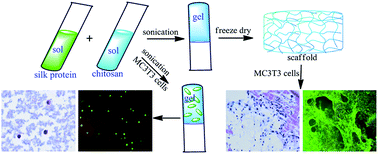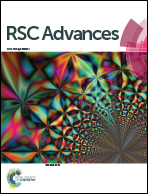Silk/chitosan biohybrid hydrogels and scaffolds via green technology
Abstract
Silk fibroin protein-based hydrogels and 3D scaffolds in combinations with chitosan were designed with a focus on green technology. The physico-chemical properties were modulated using ultrasonication processing to avoid the use of organic solvents or chemical crosslinking. The ultrasonication of mixtures of silk and chitosan induced a conformational change of the silk from random coil to β-sheet resulting in the self-assembly of the hydrophobic peptide segments in the protein, entrapping chitosan chains in these silk networks. These biohybrid materials were prepared with different physico-chemical properties by varying the relative concentrations of silk and chitosan. In combination with lyophilization, interconnected porous 3D scaffolds with controlled morphologies were generated. MC3T3-E1 cells were successfully encapsulated in silk fibroin protein and silk fibroin protein–chitosan hydrogels and colonized the scaffolds. These engineered biohybrid hydrogel and scaffold network systems can be utilized to encapsulate bioactive molecules, thus providing a versatile set of biomaterials with retention of degradability, but without the use of organic solvents or chemical crosslinking during preparation.


 Please wait while we load your content...
Please wait while we load your content...